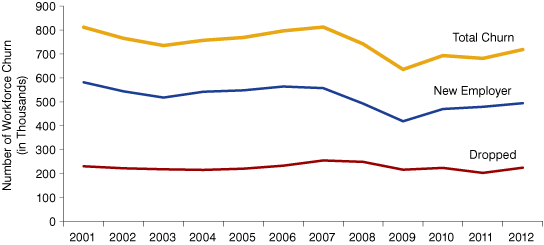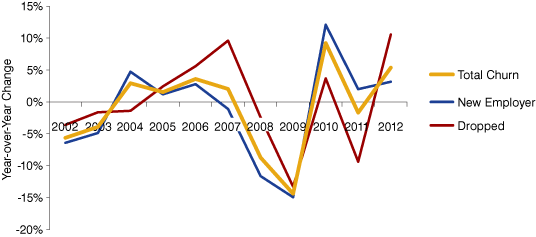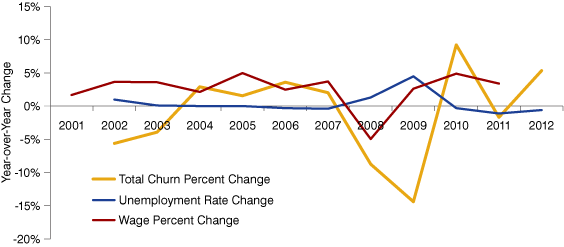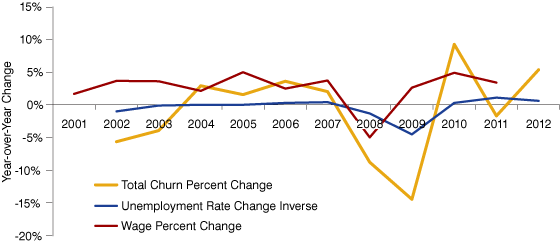Understanding the Benefits of Workforce Churn
The importance of workforce churn in a healthy labor market is often overlooked. The topic does not create media buzz and is often misinterpreted as a detriment. Being a product of the ’70s and ’80s, the word churn conjures up images of shark chum and the pulsating theme from “Jaws.”
While I don’t suppose others have this same reaction, there always seems to be a negative connotation associated with workforce churn. It could be that many people long for a time when individuals worked for a single company their entire careers. Perhaps the idea of switching jobs and the resulting increased uncertainty goes against society’s tendency toward risk aversion.
Despite the concerns, a modest level of workforce churn is both acceptable and beneficial, while extreme movements can signal problems in the labor market. Income opportunity is a major benefit of churn. As a person increases their skills and value, the ability to seek higher wages in an open labor market is a benefit to the greater society. Limiting or restricting this worker mobility would likely signal less opportunity for advancing wages. If a person were stuck at a particular position or company, the potential for income advancement would likely be hindered. When economists discuss “full employment” they do not imply a zero percent unemployment rate. They assume an unemployment rate of 2 percent to 5 percent. This remaining unemployment is called “frictional unemployment” which is acceptable and allows for the benefits of worker mobility.
Indiana Churn
In an effort to understand the churn in Indiana’s labor market, historical wage records were pulled from the Indiana Workforce Intelligence System (IWIS). It contains records from the administrative Indiana Department of Workforce Development (DWD), which are collected quarterly. However, the quarterly data increase volatility, so yearly averages were employed to help smooth seasonal effects.
The first measure examined was the new employer count. From one quarter to the next, the wage records were compared to determine which employees had switched to a new employer. The count of individuals with new employers was then summed for the quarter. The four quarters for the year were averaged. It should be noted that this measure is not without flaws. For example, individuals within a large company may be transferred between departments or facilities. Depending on the coding of the DWD administrative records, this might be signaled as a change of employer, though it could easily be argued otherwise. Additionally, this count might be inflated some due to treatment of temporary or second jobs. This analysis treats movement with multiple job holders as a count, even when the primary job might have been constant. This count has the potential to be slightly inflated for these reasons. (Some efforts could be expended to reduce these effects, but for the purposes of this analysis, the absolute count was less important than the overall trend.)
A second measure compared wage records to determine which individuals dropped out of the workforce. The count of dropped individuals was summed for the quarter, and the quarters were averaged for the year. The cause was not determined. They could have sought employment out of state, moved for personal reasons, became unemployed, retired or any number of other reasons. The dropped measure was not susceptible to the count inflation of the new employer measure. The person was present one quarter and not the next.
The two measures of workforce churn were pulled and summed as a total (see Figure 1). The results are presented numerically.
Figure 1: Total Workforce Churn in Indiana, 2001 to 2012

Source: Indiana Department of Workforce Development, using Indiana Workforce Intelligence System data
The new employer average count peaked in 2001, but remained relatively stable until 2006. After 2006, it fell until 2009 and has since recovered modestly. The dropped average count remained more stable through the analysis time frame. There was a slight buildup in 2007 and 2008 and a decline thereafter.
The level of workforce churn in Indiana likely comes as a surprise to many. During the time period studied, on average, about 8 percent of the workforce disappeared from the wage record each quarter. An additional 18 percent were listed with a new employer. A significant portion of Indiana’s workforce was in motion from quarter to quarter.
The rates of change over time appeared to be modest, given that the lines tend to be fairly flat. In an effort to magnify small changes in workforce churn, the data were computed as percentage change from one year to the next. In this way, minor changes in the measures would be amplified (see Figure 2).
Figure 2: Indiana Workforce Churn Year-over-Year Percentage Change, 2002 to 2012

Source: Indiana Department of Workforce Development, using Indiana Workforce Intelligence System data
Figure 2 illustrates that the general trends of the measures were similar. There were modest increases in workforce churn from 2002 through 2006 and 2007. After 2007, there was a dramatic decrease in workforce churn associated with the economic downturn. The workforce churn began an uneven recovery from the 2009 bottom, but increased in 2012.
Churn During and After the Recession
The first thing to note was that workforce churn decreased during the 2007 recession period. It might be natural to assume that workforce churn would increase during a recession as people lost employment. However, the data suggest otherwise. From 2006 to 2007, the workers finding new employers started to decline. There was a spike in dropped workers in 2007, likely an indication of increased worker displacement at the onset of the recession. After 2007, both churn measures dropped precipitously. As workforce churn is healthy, the onset of the recession had a profound impact on worker movement. After the initial round of layoffs (the spike in dropped workers), the labor markets froze with inactivity. The freezing in the labor markets resulted in higher unemployment and reduced (or negative) wage growth.
Evidence of the relationship between workforce churn and its importance to the overall economy (such as unemployment and wages) were examined by plotting changes and comparing for correlation. Total churn was compared to the changes in the Indiana yearly average unemployment rate change and wage percent change in Figure 3.
Figure 3: Indiana Workforce Total Churn Percentage Comparison to Annual Average Unemployment Rate Change and Wage Percent Change, 2001 to 2012

Source: Indiana Department of Workforce Development, using Indiana Workforce Intelligence System data
As workforce churn numbers grew modestly from 2003 to 2006, the unemployment rate decreased slightly and wage growth held steady. Between 2007 and 2009, the workforce market froze (lower rates of workforce churn), unemployment spiked and wage growth went negative. After 2009, workforce churn worked back unevenly toward normal levels while unemployment rates and wages began to recover.
To further illustrate the correlation of these elements within the labor market, the inverse of the unemployment rate change was taken and overlaid with the total churn and wage growth. Figure 4 demonstrates the importance of even slight movements in workforce churn on the labor market, the broader economy and future trends.
Figure 4: Indiana Workforce Total Churn Percentage Comparison to Annual Average Unemployment Rate Change Inverse and Wage Percent Change, 2001 to 2012

Source: Indiana Department of Workforce Development, using Indiana Workforce Intelligence System data
Conclusion
While one might wish for a romanticized version of a static workforce, the data suggest that the marketplace for skills within the labor market is a turbulent mix of supply and demand. Nearly 8 percent of Indiana’s entire workforce leaves the labor market from one quarter to the next (in excess of 200,000 Hoosiers by quarter since 2007). In total, about 25 percent of the total workforce experiences some type of change or movement in the labor market each quarter.
Rather than being a negative, the analysis suggests that a vibrant and chaotic labor market with large percentages of workforce movement is correlated with less unemployment and positive wage growth. The conclusion of workforce mobility and churn as beneficial at these levels has corroboration in current literature.1
The features of a healthy labor market work in concert rather than opposition. While it is easy to idealize static labor markets, the implication of such an environment would be a scene of higher levels of unemployment and lower rates of wage growth. Workforce churn is much larger than generally perceived and has an important role in the economy. Its impacts are both substantial and positively tied to other beneficial outcomes within the labor market.
Notes
- Quentin Fottrell, "Typical U.S. worker now lasts 4.6 years on job," MarketWatch, January 12, 2014, www.marketwatch.com/story/americans-less-likely-to-change-jobs-now-than-in-1980s-2014-01-10.
